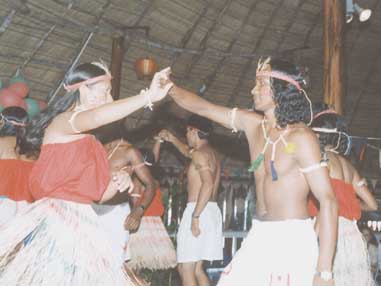
Amerindian Chain Dance
Yesterday marked the
beginning of Amerindian Heritage Month, the thirty days in the year when
we remember the contribution of the indigenous peoples to Guyanese culture,
and their role in our historical evolution as a nation. Amerindian history
begins thousands of years before the advent of the Europeans in this part
of the world, but it is not always recognised that the autochthonous peoples
were not simply bystanders during the colonial period either. Their role
was multifaceted, depending on which nation was involved, and on the particular
times and historical circumstances in which they happened to find themselves.
Given the tiny numbers of Dutch and Africans
who came here initially (only sixty, or perhaps eighty Dutch men and boys
plus six Africans arrived in Berbice in 1627), Amerindian assistance was
essential for the survival of the infant colonies. Some of the indigenous
nations were to continue to supply foodstuffs to the plantations - especially
salt fish rations for the slave population - for more than a hundred years
after the arrival of the first European settlers, and the authorities
and the planters were also to remain dependent on them for a range of
other commodities. These included hammocks and corials, the second of
which were used by everyone, including the Africans.
What is not realized, however, is that
the Arawaks, Akawaios and Caribs in particular, were export commodity
producers, particularly in the seventeenth century. In addition to balsam
copaiva and (in Essequibo only) letterwood, there was anatto. This red-orange
dye was employed in the colouring of Dutch cheeses, and for many decades
it was second only to sugar in terms of export value. The dye was processed
into little balls by the Amerindian women, and set in crab oil to preserve
it during transportation to the Netherlands.
What is also rarely acknowledged is that
members of some Amerindian nations shared the same fate as the Africans,
being slaves on the plantations. The colony of Essequibo was the centre
of an Amerindian slave trade prosecuted by the Carib nation, and mostly
managed by Surinamers from the beginning of the eighteenth century onwards.
The slaves traded or captured came from the periphery of the colony, or
outside it altogether, and they endured the same brutal conditions as
their African counterparts. Many of them were women put to work in the
bread gardens or cassava fields, which produced the cassava bread which
everyone ate in an era when wheat flour was unobtainable. Amerindian slavery
ended before African slavery in 1793.
While the popular view of the Amerindians
during the slavery period is that they acted as plantation policemen,
this only became a function of the coastal nations alone after about 1770,
and in the case of the Caribs rather earlier than this. It has to be remembered
that Amerindian slaves ran away from the plantations with as great a frequency
as African ones, were returned by the Caribs in the same way as African
ones, and were punished by the Europeans in the same fashion as African
ones. In addition some Amerindians - including members of free nations
- took part in risings, most notably the 1687 revolt in Berbice.
And what about the Caribs, who largely
ran the slave trade and who in Essequibo were a pillar of support for
the Dutch? They have to be seen as the geopoliticians of the region in
the Dutch period. Under enormous pressure from the Spaniards on both sides
of the Orinoco where they were being rounded up by force and confined
in missions, they turned to the Dutch for the European weaponry they knew
was essential if they were to resist the Spanish successfully. It was
the slave trade in particular, which gave them access to guns and to knowledge
about European battle tactics, although the Dutch authorities sometimes
armed them too in times of slave revolt.
The Caribs considered that their own survival
was bound up with the maintenance of the Dutch plantation system in the
Guianas, and down until the 1790s, they therefore remained in alliance
with the Essequibo authorities, monitoring the frontiers of the colony
for them and watching the plantations. With the Dutch alliance secure,
the Caribs could then attack the Jesuit and Capuchin missions on the Orinoco
which they rightly perceived as the instrument of Spanish penetration
in the region.
The history of the plantation and the slavery period in general, therefore, is not just the history of the Europeans and the Africans. It is also the history of the Amerindians, something which needs to be acknowledged in our classrooms.